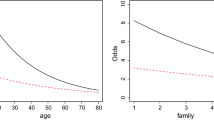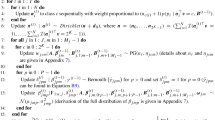Abstract
The PARELLA model is a probabilistic parallelogram model that can be used for the measurement of latent attitudes or latent preferences. The data analyzed are the dichotomous responses of persons to stimuli, with a one (zero) indicating agreement (disagreement) with the content of the stimulus. The model provides a unidimensional representation of persons and items. The response probabilities are a function of the distance between person and stimulus: the smaller the distance, the larger the probability that a person will agree with the content of the stimulus. An estimation procedure based on expectation maximization and marginal maximum likelihood is developed and the quality of the resulting parameter estimates evaluated.
Similar content being viewed by others
References
Andersen, E. B. (1970). Asymptoticl proerties of conditional maximum likelihood estimators.Journal of the Royal Statistical Society, Series B, 32, 283–301.
Andersen, E. B., & Madsen, M. (1977). Estimating the parmeters of the latent population distribution.Psychometrika, 42, 357–374.
Andrich, D. (1988). The application of an unfolding model of the PIRT type to the measurement of attitude.Applied Psychological Measurement, 12, 33–51.
Bock, R. D. (1988).BILOG. Chicago: Scientific Software.
Bock, R. D., & Aitkin, M. (1981). Marginal maximum likelihood estimation of item parameters: application of an EM algorithm.Psychometrika, 46, 443–459.
Bock, R. D., & Lieberman, M. (1970). Fitting a response model forn dichotomously scored items.Psychometrika, 35, 179–197.
Cliff, N., Collins, L. M., Zatkin, J., Gallipeau, D., & McCormick, D. J. (1988). An ordinal scaling method for questionnaire and other ordinal data.Applied Psychological Measurement, 12, 83–97.
Coombs, C. H. (1964).A theory of data. Ann Arbor: Mathesis Press.
Davison, M. L. (1977). On a metric unidimensional unfolding model for attitudinal and developmental data.Psychometrika, 42, 523–548.
Dempster, A. P., Laird, N. M., & Rubin, D. B. (1977). Maximum likelihood from incomplete data via the EM algorithm.Journal of the Royal Statistical Society, Series B, 39, 1–38.
DeSarbo, W. S., & Hoffman, D. L. (1986). Simple and weighted unfolding threshold models for the spatial representation of binary choice data.Applied Psychological Measurement, 10, 247–264.
Engelen, R. J. H. (1987).Semiparametric estimation in the Rasch model (Research Report 87-1). Twente, The Netherlands: University of Twente.
Fischer, G. H. (1987).Einfuhrung in die theorie psychologischer Tests: Grundlagen and Anwendungen [Introduction to the theory of psychological test: Fundamentals and applications]. Bern: Huber.
fischer, G. H. (1974). Applying the principles of specific objectivity and of generalizability to the measurement of change.Psychometrika, 52, 565–587.
Glas, C. A. W. (1988). The derivation of some tests for the Rasch model from the multinomial distribution.Psychometrika, 52, 525–546.
Haberman, S. J. (1977). Maximum likelihood estimation in exponential response models.The Annals of Statistics, 5, 815–841.
Hartley, H. O. (1958). Maximum likelihood estimation from incomplete data.Biometrics, 14, 174–194.
Hartley, H. O., & Hocking, R. R. (1971). The analysis of incomplete data.Biometrics, 27, 783–808.
Hoijtink, H. (1990).PARELLA, measurement of latent traits by poximity items. Leiden: DSWO Press.
Jansen, P. G. W. (1983).Rasch analysis of attitudinal data. Doctoral dissertation, State Psychological Service, Catholic University of Nymegen, The Netherlands.
Kennedy, Jr., W. J., & Gentle, J. E. (1980).Statistical computing. New York: Dekker.
Kiewiet, D. J. (1988).Een programma voor de schatting van persoons-parameters in het PPPA-model [A program for the estimation of person parameters in the PARELLA model] (HB-88-937-SW). Heymans Bulletins Psychologische Instituten R. U. Groningen.
Laird, N. (1978). Nonparametric maximum likelihood estimation of a mixing distribution.Journal of the American Statistical Association, 73, 805–811.
Louis, T. A. (1982). Finding the observed information matrix when using the EM algorithm.Journal of the Royal Statistical Society, Series B, 44, 226, 233.
Mislevy, R. J., & Bock, R. D. (1982). Biweight estimates of latent ability.Journal of Educational and Psychological Measurement, 42, 725–737.
Mokken, R. J. (1970).A theory and procedure of scale analysis. 'S-Gravenhage: Mouton.
Molenaar, I. W. (1983). Some improved diagnostics for failure of the Rasch Model.Psychometrika, 48, 49–57.
Molenaar, I. W., & Hoijtink, H. (1990). The many null distributions of person fit indices.Psychometrika, 55, 75–105.
Ramsay, J. O. (1975). Solving implicit equations in psychometric data analysis.Psychometrika, 40, 337–360.
Rapoport, R. B., Abramowitz, A. I., & McGlennon, J. (1986).The life of the parties. Lexington: The University Press of Kentucky.
Sanathana, L., & Blumenthal, S. (1978). The logistic model and estimation of latent structure.Journal of the American Statistical Association, 73, 794–799.
Stroud, A. H., & Sechrest, D. (1966).Gaussian quadrature formulas. Englewood Cliffs, NJ: Prentice Hall.
Takane, Y. (1983). Choice model analysis of the pick any/n type of binary data. Handout for the talk given at the European Psychometric and Classification Meeting, Jouy-en-Josas, France.
Thissen, D. (1982). Marginal maximum likelihood estimation for the one-parameter logistic model.Psychometrika, 47, 175–186.
van den Wollenberg, A. L. (1982). Two new test statistics for the Rasch model.Psychometrika, 47, 123–140.
van Schuur, W. H. (1984).Structure in political beliefs. Amsterdam: CT Press.
Wainer, H., & Wright, B. D. (1980). Robust estimation of ability in the Rasch model.Psychometrika, 45, 373–391.
Wright, B. D., & Douglas, G. A. (1977). Best procedures for sample free item analysis.Applied Psychological Measurement, 1, 281–294.
Author information
Authors and Affiliations
Additional information
I gratefully acknowledge Ivo Molenaar and Wijbrandt van Schuur for their advice and encouragement during the course of the investigation, Derk-Jan Kiewiet who constructed the program for the ML estimator for the person parameter and Anne Boomsma, Wendy Post, Tom Snijders, and David Thissen for their comments on smaller aspects of the investigation.
Rights and permissions
About this article
Cite this article
Hoijtink, H. A latent trait model for dichotomous choice data. Psychometrika 55, 641–656 (1990). https://doi.org/10.1007/BF02294613
Received:
Revised:
Issue Date:
DOI: https://doi.org/10.1007/BF02294613




